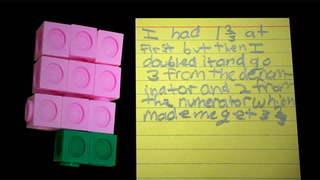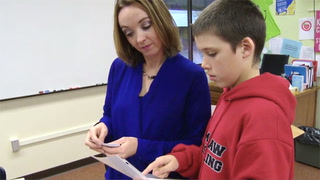Series Meeting Students' Needs in Number Talks: Learning Menus: Giving Options & Independence
Math.6.NS.A.1
Common core State Standards
- Math: Math
- 6: Grade 6
- NS: The Number System
- A: Apply and extend previous understandings of multiplication and division to divide fractions by fractions
-
1:
Interpret and compute quotients of fractions, and solve word problems involving division of fractions by fractions, e.g., by using visual fraction models and equations to represent the problem. For example, create a story context for (2/3) ÷ (3/4) and use a visual fraction model to show the quotient; use the relationship between multiplication and division to explain that (2/3) ÷ (3/4) = 8/9 because 3/4 of 8/9 is 2/3. (In general, (a/b) ÷ (c/d) = ad/bc.) How much chocolate will each person get if 3 people share 1/2 lb of chocolate equally? How many 3/4-cup servings are in 2/3 of a cup of yogurt? How wide is a rectangular strip of land with length 3/4 mi and area 1/2 square mi?.
Save to My Resources
PLEASE CREATE A NEW ACCOUNT OR LOG IN TO ACCESS THIS CONTENT
Enjoy your first video for free. Subscribe for unlimited access.
Have questions about subscribing?
Click Here to learn more about individual subscriptions.
Click Here to learn more about School and Institution access.
Discussion and Supporting Materials
Thought starters
- How do learning menus enable Ms. Morey to provide differentiated instruction?
- Why does Ms. Morey allow students to sometimes choose which tasks she assesses?
- What resources does Ms. Morey use to design her menu tasks?
In Partnership With:

School Details
Enumclaw Middle School550 Semanski Street
Enumclaw WA 98022
Population: 498
Data Provided By:

Teachers
Crystal Morey
Math / Kindergarten 1 2 3 4 6 / Coach
Newest
|
4 MIN
|
5 MIN
|
5 MIN
UNCUT CLASSROOMS
| TCHERS' VOICE
English Language Arts











15 Comments
Dakota Sky Larson Nov 13, 2019 5:14pm
I love that this teacher goes beyond the curriculum to find application-based problems for the students to choose from. This is a great way for students to practice self discipline, because they get to decide what concepts to work on. I like that it gives students a break from classmates so they can focus on what concepts they need to improve on, while also giving the teacher a chance to work more closely with a handful of students at a time. Probably my favorite part about this teaching method is that the students are given a warm up, or “appetizer” problem before choosing what they want to focus on. I think this is a great way to build the student’s confidence in their abilities and make them want to challenge themselves in the “main course.” I love that this video shows other resources that are available to the students to help them complete their worksheets, like blocks. Of course, the best part of all of this, is that the students seem to be having a lot of fun.
Jacqueline Shingler May 6, 2019 11:25am
I like how she uses the menu math to differentiate their independent station. I also like how they know how they will be assessed. My questions are:
How often does she meet with small groups?
How often does she formally assess her students?
Area all the menu options related to one object?
I could see this being used in my stations for my inclusion class.
John DeMeo Jun 30, 2018 6:05pm
Kellye McCoy Mar 7, 2018 11:39am
Uma Mahajan Aug 16, 2017 3:48pm